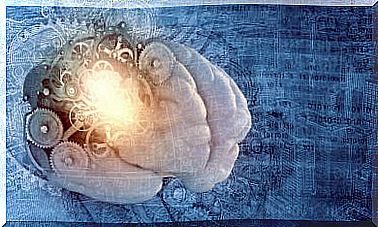What Is Olfactory Memory And How Does It Work?

Have you ever bought a product and its smell has brought you back to childhood? Have you ever bought a cookie that smelled like the ones Grandma made? All of this is related to what we call olfactory memory. It is the most primary type of memory and has a great connection with our emotions. We are talking about a power that big brands know well and that they use to motivate us to buy their products.
It is important to clarify that the sense of smell is a chemical system. Therefore, it is responsible for detecting the chemicals that generate aromas in the environment. This processing is essential for survival, as it helps us detect substances that can become risky for our lives, such as spoiled food.
It is also one of the most effective senses. This is because it enters the brain structures that process its information more directly. To complete the odor assimilation process, some steps must be followed:
- The odor molecules, which are floating in the air, reach the nostrils through the mucous membranes. These dissolve in molecules so that they can be captured.
- Beneath the mucosa is a layer called the olfactory epithelium. This structure has receptor neurons, specialized in detecting odors.
- Neurons are responsible for sending information to the olfactory bulb. A brain structure that is just behind the nose.
- The bulb presents sensory receptors, which send messages to structures of the limbic system. This system is responsible for processing emotional information and helps to consolidate memories. It also sends information to the dorsal cortex, which helps in the modification of conscious thoughts.
Therefore, the final structures where the information arrives are those that help the olfactory memory to develop. With it we can relate smells and memories. Thus helping the process of evocation and recognition of multiple aspects of our daily life.

Limbic system and olfactory memory
As we know, the limbic system is essential for the consolidation of information related to olfactory memory. This system is made up of structures such as: amygdala, thalamus, cingulate gyrus, among others. It is linked to involuntary or instinctual responses, it also helps to process emotional information and endows stimuli with this characteristic.
In the endowment of emotion, the amygdala is the one that takes center stage, since it is immediately activated by an olfactory perception. This can give the scent an excitement or spark memories with it. All this involves olfactory memory processes, such as the consolidation of new information or the evocation or maintenance of it.
This system is one of the oldest in the brain and is responsible for less rational actions. This means that the information that is consolidated in the olfactory memory can incentivize certain decisions without going through the filter of reflection.
Cognitive process involved in olfactory memory
As we know, what we perceive by smell is not rationally filtered easily. Even so, it has an impact on emotional and social aspects. There are several processes that occur in the brain to help consolidate olfactory memory information, among them are the following:
- Perception. It consists of capturing the external aroma to identify it and differentiate it from others. The result will be a mental representation of the aroma and it will be related to a meaning.
- Sensation. Here, a subjective interpretation and representation of this aroma is made. In most cases we associate it as pleasant and unpleasant. The conception of this classification is closely related to the individual, social and cultural variables themselves.
- Emotion. In olfactory memory this aspect takes a great role, as we saw previously, it is processed mainly by our emotional brain. Therefore, it is usually the most relevant aspect of this type of memory. On many occasions we can evoke emotions much more easily than with other types of memory.
- Associations. In this case, emotion tends to gain prominence, but here there is a presence of conscious thought. Therefore, associations of elements and specific situations are made with the aromas and over time this memory can be voluntarily evoked.
- Storage. It is related to long-term memory, which is the case with most olfactory information. This process is usually influenced by context and personal characteristics.

Olfactory memory and marketing
This is one of the new approaches that marketing has. In it, aroma and olfactory memory take center stage within a business. It is usually used to better promote and sell a certain product. The purpose is to promote or favor certain emotions that can motivate consumption.
Therefore, this type of marketing uses one of the senses that most influences the purchase decision, smell. This is due to its power as a driver of action. To fulfill their objective they develop an olfactory logo or odotype. Through this, it can help to fix in memory the memory of a specific brand.
It is important that the odotype evokes feelings, values, emotions and memories. Likewise, it must be sufficiently recognizable and distinguishable from other types of odors, especially from other brands that are direct competition. In addition, the odotype gains value the greater its power to evoke positive memories.
In summary, we can understand that olfactory memory, through its direct communication channel with our decision centers, plays an important role in our lives. This direct communication is known by large companies, who do not hesitate to exploit it knowing that it is one of the options to awaken our hunger for consumption in the face of rational decision-making.









